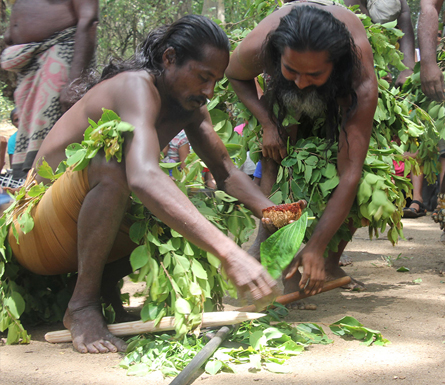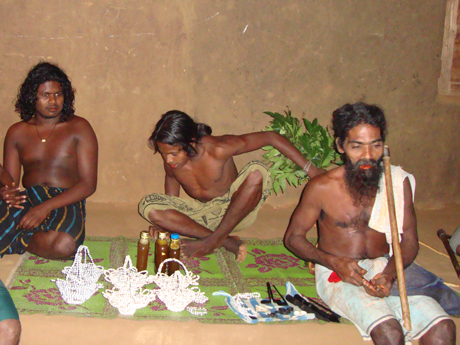

The Sri Lankan Adivasi or Aboriginal community is commonly known as Veddas.The term Vedda originates from the Sanskrit word vyadha,which means hunter. The Adivasis were originally hunters and gatherers. They are known as Wanniya-laettowhich means “forest-beings”. The Adivasis are minoritized indigenous groups in Sri Lanka.
According to popular myth, supported by the historical source of Mahawansa, the ancestors of Sri Lanka's current Sinhalese majority, who came to the island from North-East India in the 5th century BC, brutally destroyed the native Yakkhaand Naga population. According to this myth, the Adivasi people emerged from the offspring of the Indian price Vijaya and a Yakkha woman named Kuveni, while another source states that Yakkhaand the Adivasi are in fact the same indigenous people. However, this myth is refuted by main Adivasi groups in Sri Lanka andthey believe that their history goes beyond these mythical legends.
Traditional Adivasi settlements are in the hilly and heavily forested central part of the island.In the past, the Ratnapura District, a part of the Sabaragamuwa Province, was known to be inhabited by the Adivasi people since the name Sabaragamuwa was believed to have meant “the village of Sabaras” or “primitive forest dwellers”. Terms such as Vedda-gala(Vedda Rock), Vedda-ela(Vedda Canal) and Vedi-kanda(Vedda Mountain) in the Ratnapura district are examples for this. The Adivasis still live in some of the areas including Bintenne in Uva District, Anuradhapura District in the North Central Province, coastal areas of the Eastern Province; however, their habitat is shrunk and currently limited to the following eleven settlements: Rathugala, Pol-lebadda, Dambana, Hennanigala, Laggala, Nilgala, Dalukana, Sorabora, Dimbulagala, Kukulagala, and Vakarai.
Due to the introduction of government development projects and schemes, especially the Mahaweli development project in 1983, many Adivasi families were resettled in different places and as a result, they had to adapt to the changes in their traditional life style caused by settlements.
In his book, The Veddas,C. G. Seligman (1901) categorizes Veddas into three distinctive groups:
As an indigenous group, some unique features are visible in their culture. The so-called cultural identity can be seen in their rituals (Shanthi Karma), language, food consumption, birth and marriage customs and in arts. According to custom, the leadership of an Adivasi groupis passed down from father to son. The leader is selected by the elders of the Adivasi peopleand he should respect the rules of the clan and protect the people in the group. The present leader of the Adivasi community is Uruwarige Wannila Attho, who lives in Dambana.
The decisions making body of the clan is called warigasabhawa.The warigasabhawa is called by the leader of the Adivasi group, once a year. All regional leaders have to be present to take decisions and solve problems.
Even though there were 14 sub-groups or clans, only six groups remain at present. Sub groups are identified by their family names. These are:
Worship of ancestral gods (Ne yakun) is the main ritual or shantikarma of the Adivasi people. To prevent and cure all diseases and injuries, people worship their ancestral gods with ritualistic performances accompanied by dance and music. Some rituals are performed annually and others have no specific period. Hakma dance, Kirikora dance,and Hangala dance,are the main Rituals of the main Adivasi group. All these ritualistic performances are conducted to ward off diseases, to make hunting successful, to acquire a bountiful harvest of bee honey and to protect their chena cultivation from wild animals. Aside from these main rituals, mantras are chanted to ward off evil influences of demons.
The language of the Adivasis is called the Vadi Bhashawa.The language is transmitted orally.
Ex:-
1. To denote tings and places, suffix " Pojja" is used
| Vavpojja | - Lake |
| Rukulpojja | - Home |
| Bus Pojja | - Bus |
| Tv Pojja | - Television |
| AmmilaAthto | - Mother |
| AppilaAthto | - Father |
| OyaAthto | - you |
The Songs of the Adivasis are known as Vadi Gee.All these songs are considered spontaneous creations of the Adivasi people. All these songs are connected with day to day activities. Lullabies, love songs, bee hunters’ songs, and mantras are commonly sung by the Adivasi people. The Adivasis use such songs and verses to preserve and pass their traditional knowledge to the future generation. However, due to the influence of modern mass media culture, the identity of their music and songs has been changing. They have formed traditional orchestras and perform their traditional music at official functions in different parts of the country.
Traditionally, the Adivasi people use the Daul drum to play rhythm. The Daula is the main percussion instrument used in the Sabaragamuwa dance tradition. As far as the historical records are concerned, this drum has been appropriated by the Sabaragamuwa dance tradition, from the Adivasi groups. Along with the daul drum, some rattles are used.

People who are living in Adivasi groups create different ornaments as their artefacts such: axe, bow, necklaces using woods and animal bones and teeth.

